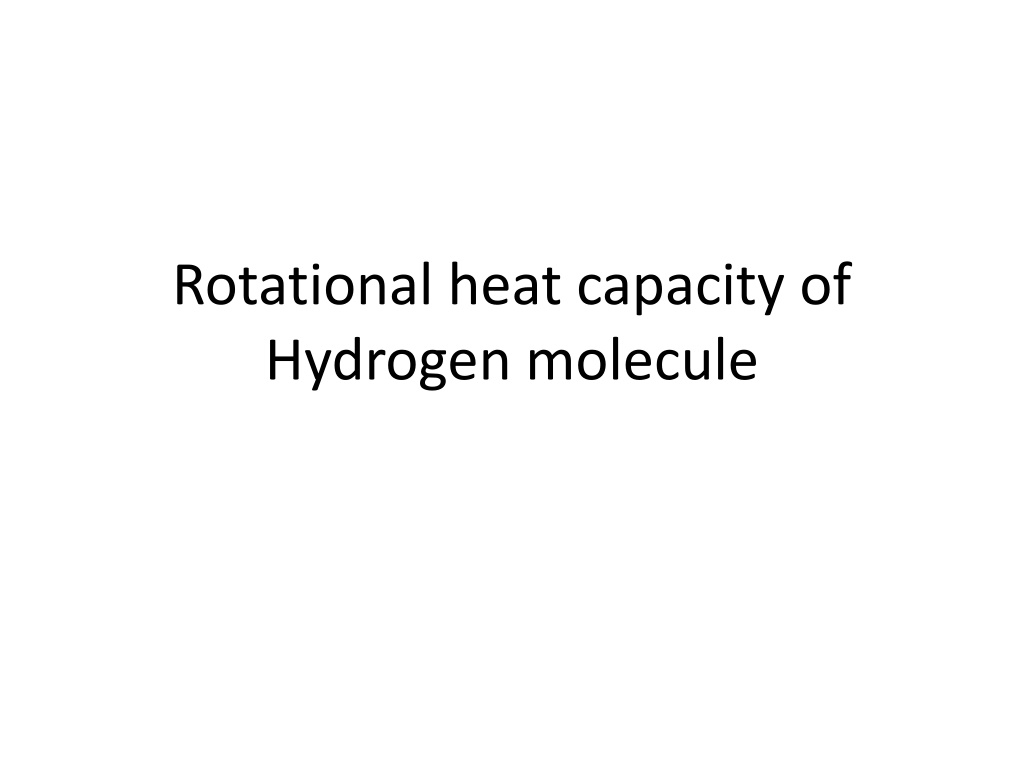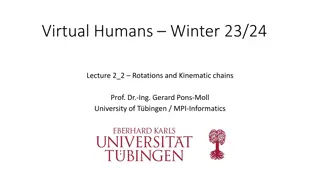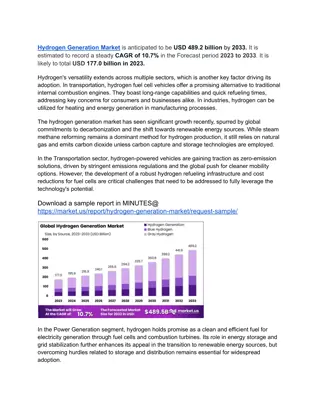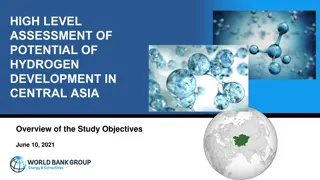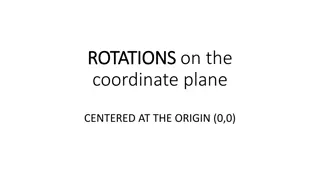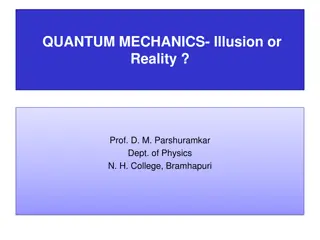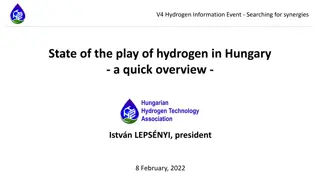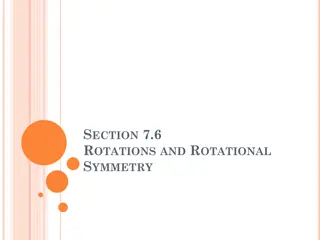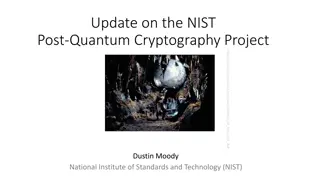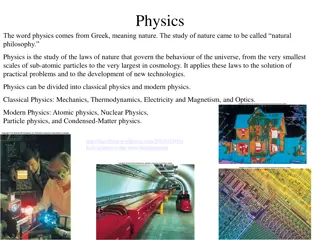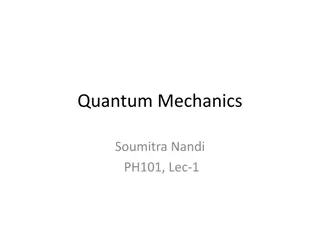Quantum Mechanics of Hydrogen Molecule Rotations
Dive into the intriguing world of molecular rotations in hydrogen molecules, exploring topics such as rotational heat capacity, moment of inertia, nuclear spin isomers, and wave number calculations. Understand the implications of particle interactions, distinguishable vs. indistinguishable particles, and the importance of symmetry in wave functions. Unravel the complexities of quantum mechanics that govern the behaviors of these fundamental particles.
Download Presentation

Please find below an Image/Link to download the presentation.
The content on the website is provided AS IS for your information and personal use only. It may not be sold, licensed, or shared on other websites without obtaining consent from the author.If you encounter any issues during the download, it is possible that the publisher has removed the file from their server.
You are allowed to download the files provided on this website for personal or commercial use, subject to the condition that they are used lawfully. All files are the property of their respective owners.
The content on the website is provided AS IS for your information and personal use only. It may not be sold, licensed, or shared on other websites without obtaining consent from the author.
E N D
Presentation Transcript
Rotational heat capacity of Hydrogen molecule
Moment of inertia of hydrogen very small so rotational quanta too large so classical treatment not used rotational partition function calculated only by summation But calculated value does not agree with experimental value
Difference is due to two nuclear spin isomers for hydrogen molecule Nuclear spin of the two protons can be paired to get either symmetric combination (spin parallel) or antisymmetric combination (spin opposed) Former is ortho and latter para hydrogen
Wave number = hJ/42Ic for rotational space of diatomic molecule Spectra of ortho hydrogen has fairly intense lines corresponding to odd values of J Para hydrogen has less intense lines corresponding to even value of J Spectra of hydrogen has alternating intense and less intense rotational lines shows that mixture contains ortho(75%) and para hydrogen
If system has non-interacting particles, wave function for over all system is product of wave function of all particles For particles 1 and 2 a(1) or a(1) , b(2) or b(2) For combination I= a(1) b(2) = a(1)b(2)
If indistingushiable particles, same wave function can be available for both So II= a(2) b(1) = a(2)b(1) is also valid But by quantum mechanics this is not acceptable
To correct this use in phase(+) and out phase(-) combinations of 1and 2 for in phase = symmetric= s Out phase = antisymmetric = a s= c ( I+ II) = c [a(1)b(2) + a(2)b(1) a= c ( I- II) = c [a(1)b(2) a(2)b(1) C is normalising constant = 1/ 2
Interchanging of labels leaves sunchanged and abecomes - a Etotal= Ee+ Et+ Ev+ Er+ En total= e+ t+ v+ r+ n If sum of numbers of proton , electron and neutron = P , is even must be symmetric and only sis allowed If P is odd, antisymmetric- ais allowed
Symmetry of on exchange will depend on whether exchange of nuclei 0r electrons or both If only nuclei exchanged effects of electron exchange not considered but effect of nuclear exchange on ecan be considered ris characterised by quantum number J , each J value is associated with (2J + 1) function
ris symmetric if J is even antisymmetric if J is odd ris a function of angles and Nuclear exchange means changing to ( - ) and to ( + ) Hydrogen has odd number of particles so antisymmetric
n depends on inter nuclear separation so nuclear exchange has no effect n is therefore symmetric It hydrogen in electronic ground state e has symmetric g+, + means function is symmetric and symmetric w.r.t inversion as given by g So over all wave function is symmetric
If H-H is assumed as A-B, each has spin+1/2 or - 1/2 The possible combination is A(+)B(+) + B(+)A(+) = A(+)B(+) A(-)B(-) + B(-)A(-) = A(-)B(-) A(+)B(-) + B(+)A(-) A(-)B(+) + B(-)A(+) both 3 &4 are similar These are symmetric nuclear spin function and has three different function.
A(+)B(-) - B(+)A(+) = 0 A(-)B(-) - B(-)A(-) = 0 A(+)B(-) - B(+)A(-) A(-)B(+) - A(-)B(+) both 3 &4 are similar these are antisymmetric and has only one function 1 & 2 are excluded
So number of symmetric wave function is 3 times more than antisymmetric wave function In general homo nuclear diatomic of spin i ratio of symmetric to antisymmetric spin function is (i+1) : I In general one with greater value is ortho and the other is para
It is possible to find combinations of wave function which make total either symmetric or antisymmetric e, vand tare symmetric so overall symmetry determined by products of r x n For hydrogen total wave function must be antisymmetric since P is odd totalto be antisymmetric either ror nmust be antisymmetric but not both
rsymmetric J is even nmust be antisymmetric(s=0) rantisymmetric J odd nsymmetric (s=1) For pare J is even, s=0 Ortho J is odd , s= 1
In general molecule in ortho state occupy odd rotational level- with pare occupy even rotational level r =BJ(J+1) B= h2/8 2I So fr(ortho) = (2s+1)s=1 J=1,3,5..(2J+1)e-BJ(J+1)/kT Since each state has nuclear statistical weight (2s+1), s=0 for para and s=1 for ortho ..(1)
So fr(para) = (2s+1)s=0 J=0,2,4..(2J+1)e-BJ(J+1)/kT From (2) as T 0 , all molecules are populated with J=0 , so no ortho form- not easy to convert ortho to para without catalyst or other reagent ..(2)
So fr(ortho) = 3 J=1,3,5..(2J+1)e-BJ(J+1)/kT So fr(para) = 1 J=0,2,4..(2J+1)e-BJ(J+1)/kT ..(1) Relative numbers of ortho to para forms of hydrogen will be in their ratio of their partition function At 300K, -B/kT = 0.3
Summation of ortho series is 3e-0.6+7e-3.6+11e-9+ . For para 1+5e-1.8+9e-6+ . For ortho series sum = 1.7 For para sum = 1.8
At higher temperatures two become similar no/np= fo/fp=(2s+1)0/(2s+1)p= 3/1 ie 25% para and 75% ortho To calculate Cv, evaluate f for ortho and para Rotational heat capacity of ordinary H2is thus 3/4Cv(ortho)+ 1/4Cv(para)at a given temperature
At low temperatures , H2molecules are in lowest possible rotational level r= J(J+1)h2/8 2I Since J=1 for ortho fr(ortho)= 9e-h2/4 2I For para J=o fr(para)=1e-0h2/8 2I=1 Cv = d/dT[RT2dlnZ/dT]v
= d/dT[LkT2dlnf/dT] Since lnf = constant Cv(ortho) = 0 Cv(para) = 0 Rotational contribution to heat capacity is zero at low temperature As temperature is raised rotational contribution becomes significance and specific heat increases.
